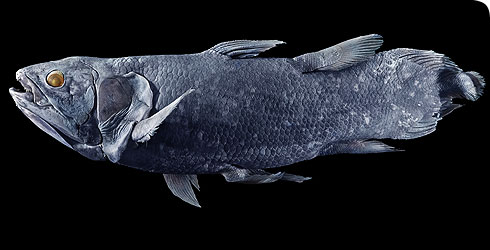Taxonomy
Classification of the coelacanths
Coelacanths (Infraclass Actinistia) are assigned to the subclass Sarcopterygii (‘lobe-finned’ fishes), and include several families. The family Latimeriidae includes the 2 species of the living coelacanth, Latimeria, as well as fossil taxa such as Macropoma lewesiensis, from the English Chalk (Cretaceous in age).
Evolution
Prior to the discovery of Latimeria chalumnae in 1938, coelacanths were only known as fossils and were thought to have become extinct near the end of the Cretaceous.
The earliest coelacanths are Devonian in age, with the most primitive being Miguashaia bureaui.
All coelacanths have an unusual tail with a small accessory lobe at the tip - this is absent in Miguashaia, whose tail is more similar to other lobe-finned fishes.
The maximum diversity of the coelacanths was during the Triassic period.
